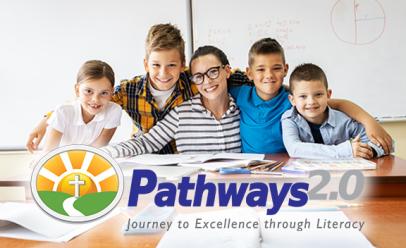 By: Kendall Hunt RPD with contributions from the editorial team of Pathways2.0
By: Kendall Hunt RPD with contributions from the editorial team of Pathways2.0
Standards-based education is centered around the idea that there are specific elements of knowledge and skill that all students should know and be able to apply as a result of their own learning experience.
A student-centered curriculum begins by providing students with clear and transparent learning goals. These are identified as standards. Student-centered learning is integral when designing an educational framework. Curriculum, assessment, and instruction are only effective when designed and delivered with consideration of each learner’s spiritual, mental, physical, social, and emotional development.
With Pathways2.0 (grades 1-8) this customized, faith-based curriculum is designed so that both teachers and students focus on these standards throughout the process of instruction and assessment. Effective processes ensure that students are provided with regular and timely feedback, based on specific references to the learning goals, for producing quality work that reflects the rigor inherent in the curriculum.
“It is the goal of Pathways2.0 to optimize literacy and language acquisition for all students,” describes an editorial development team member. “The standards provide the framework for the curriculum, instruction, and assessment practices found in the program.” This shift to standards-based teaching and learning ensures that all teachers and students adhere to developmentally appropriate, yet rigorous, expectations.
Additionally, each student engages in self-assessment and reflection, aligned to the standards. Such assessment leads to the student identifying personal goals, making self-adjustments based on prior knowledge, and transferring learning to new situations. With the expectation of increased rigor, it is important that the instructional environment is safe and supportive. Curriculum, assessment, and instruction do not operate as separate entities. Effective instruction is achieved in alignment with a cohesive, rigorous curriculum and standards-based assessment.
The standards define the literacy areas of reading, writing, speaking, listening, and Adventist education has always been about “Something Better” (White 2002), something more than meeting baseline expectations for student learning. Adventist education continues to add something of eternal value to the curriculum, instruction, and assessment that impacts student learning. The Adventist worldview will always serve as the lens through which teaching and learning occurs in the classroom. Once students graduate from Adventist schools, they’re fully equipped to work in a global community. These standards give Adventist teachers the framework to understand what students should know and be able to accomplish across the grade levels.
Whether it is reading complex text, writing a persuasive article, or presenting a topic in a coherent manner with relevant evidence, students will approach learning from a biblical perspective. The partnership of faith and learning taught from a standards-based focus ensures that students continue to “grow in wisdom and stature and in favor with God and man”— (Luke 2:52).
Pathways2.0 reading and language arts program for grades 1-8, incorporates the key instructional block of reading, writing, listening and speaking so all students can develop skills and support their comprehension and analytical skills. Reading classes also instruct students in vocabulary and spelling, and help them build their skills through instruction, practice, and testing.